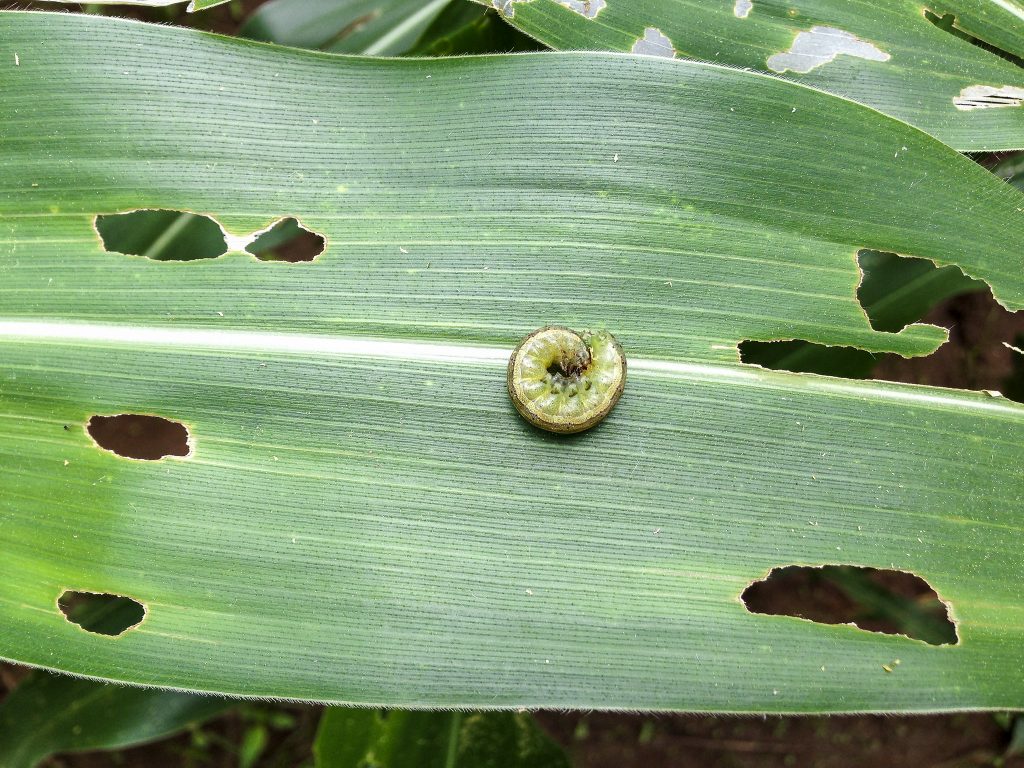
New study identifies best agronomic practices to reduce fall armyworm damage
Good weed management, conservation agriculture, and use of manure and compost are recommended to help control fall armyworm in Africa.

The fall armyworm, an invasive insect-pest native to the Americas, has caused significant damage to maize crops in sub-Saharan Africa since its arrival to the region in 2016. An integrated approach, including improved agronomic practices, is necessary in order to fight against the invasive caterpillar. However, little is known about the most effective agronomic practices that could control fall armyworm under typical African smallholder conditions. In addition, more information is needed on the impact of fall armyworm on maize yield in Africa, as previous studies have focused on data trials or farmer questionnaires rather than using data from farmer fields. In a new study published by researchers with the International Maize and Wheat Improvement Center (CIMMYT), investigators set out to understand the factors influencing fall armyworm damage and to quantify yield losses due to fall armyworm damage.
The study examined damage in smallholder maize fields in two districts of eastern Zimbabwe. “We estimated the yield losses due to fall armyworm damage at 11.57 percent in the study area. Extrapolated to the whole of Zimbabwe, this would amount to a loss of 200,000 tons of grain, or a value of more than $32 million using the average global price of maize of $163 per ton in 2018,” said Frederic Baudron, cropping systems agronomist at CIMMYT and main author of the study.
Practices such as infrequent weeding or planting on land that had previously been fallow were found to increase fall armyworm damage to maize — most likely because they increased the amount of fall armyworm host plants other than maize. Conversely, practices hypothesized to increase the abundance of natural enemies of fall armyworm — such as minimum and zero tillage or the application of manure and compost — were found to decrease fall armyworm damage. Intercropping with pumpkins was found to increase damage, possibly by offering a shelter to moths or facilitating plant-to-plant migration of the caterpillar. Fall armyworm damage was also higher for some maize varieties over others, pointing to the possibility of selecting for host plant resistance.
“Given the limited coverage of the study in terms of area and season, it would be interesting to replicate it all over the country through the involvement of governmental agricultural departments, so that we get the full picture around the fall armyworm problem at a larger scale,” said Mainassara Zaman-Allah, co-author of the study and abiotic stress phenotyping specialist at CIMMYT.
This study is unique in that it is the first to collect information on agronomic practices that can affect fall armyworm damage using data taken directly from smallholder farmer fields. “Many papers have been written on pest incidence-damage-yield relationships, but with researchers often having control over some of the potential sources of variation,” said Peter Chinwada, TAAT Fall Armyworm Compact Leader at the International Institute of Tropical Agriculture (IITA), another co-author of the study.
“Our study was driven by the desire to determine fall armyworm incidence-damage-yield relationships under typical African smallholder farmer conditions which are characterized by a diversity of cropping systems, planting dates and “pest management practices” that may have been adopted for purposes which have nothing to do with managing pests. Unravelling such relationships therefore requires not only institutional collaboration, but the meeting of minds of scientists from diverse disciplines.”
The results of the study suggest that several practices could be promoted to control fall armyworm in its new home of Africa. “Farmers have already been informed of the results by their extension agents; the NGO GOAL, present in Zimbabwe, shared the findings,” Baudron said. “The next step is to test some of the recommendations suggested in the paper to control fall armyworm such as good weed management, conservation agriculture, use of manure and compost, and stopping pumpkin intercropping. These approaches will need to be refined.”
This work was implemented by the International Maize and Wheat Improvement Center (CIMMYT), GOAL, and the University of Zimbabwe. It was made possible by the generous support of Irish Aid, Bakker Brothers and the CGIAR Research Program on Maize (MAIZE). Any opinions, findings, conclusion, or recommendations expressed in this publication are those of the authors and do not necessarily reflect the view of Irish Aid, Bakker Brothers and MAIZE.
Africa, conservation agriculture, fall armyworm, Maize, Zimbabwe
